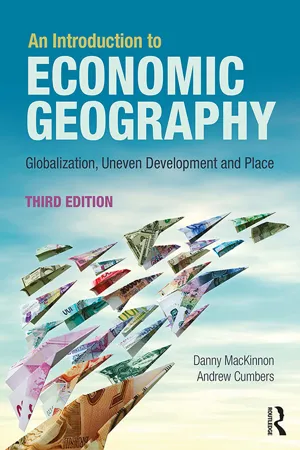
An Introduction to Economic Geography
Globalisation, Uneven Development and Place
Danny MacKinnon, Andrew Cumbers
- 428 pagine
- English
- ePUB (disponibile sull'app)
- Disponibile su iOS e Android
An Introduction to Economic Geography
Globalisation, Uneven Development and Place
Danny MacKinnon, Andrew Cumbers
Informazioni sul libro
In the context of great economic turmoil and uncertainty, the emergent conflict between continued globalisation and growing economic nationalism means that a geographical economic perspective has never been so important. An Introduction to Economic Geography guides students through the key debates of this vibrant area, exploring the range of ideas and approaches that invigorate the wider discipline.
This third edition includes new chapters on finance, cities and the digital economy, consumption and the environment. Underpinned by the themes of globalisation, uneven development and place, the text conveys the diversity of contemporary economic geography and explores the social and spatial effects of global economic restructuring. It combines a critical geographical perspective on the changing economic landscape with an appreciation of contemporary themes such as neoliberalism, financialisation, innovation and the growth of new technologies.
An Introduction to Economic Geography is an essential textbook for undergraduate students taking courses in Economic Geography, Globalisation Studies and more broadly in Human Geography. It will also be of much interest to those in Planning, Business and Management Studies and Economics.
Domande frequenti
Informazioni
Part 1
Foundations
Chapter 1
Introducing economic geography
- ➤ The main themes of the book:
- ⚫ globalisation and connections across space;
- ⚫ uneven geographical development;
- ⚫ the importance of place;
- ➤ The meaning of the economy.
- ➤ The nature of economic geography as an academic subject.
- ➤ The political economy approach to economic geography that we adopt in this book.
1.1 Introduction

1.2 Key themes: globalisation, uneven development and place
- ➤ Location is perhaps the most basic geographical concept, referring to the geographical position of people and objects relative to one another (Coe et al. 2013), i.e. where things are. This is often represented by maps (see Figure 1.1), and systems of grid references have been developed to convey this information in a precise form. It is clearly related to distance which is the area or space between locations, for example cities such as Hong Kong and London. Overcoming what geographers have traditionally called the 'friction of distance (the effort and cost of moving objects and people between locations) requires time and money, for example the price of a long haul flight between London and Hong Kong. The greatly increased ability of economic actors such as Transnational corporations (TNCs) and banks to move money, goods, services, information and people over large distances as a result of the development in transport and communication technologies has been of great significance for the reorganisation of the international economy in recent decades.
- ➤ Scale refers to the different geographical levels of human activity, from the local to the regional, national and global (Figure 1.2). They are important to the definition and organisation of economies as indicated by the common use of terms such as the local economy, national economy and global economy by policy-makers, media commentators and citizens. It is important to see these different scales of economic organisation as overlapping and interconnected rather than viewing them as entirely separate.
- ➤ Space is an area of the earth's surface such as that contained within the boundaries of a particular region or country. It is perhaps the most abstract and difficult to grasp of the geographical concepts introduced here, and is best understood by being related to distance and place. Although a more general term, space is related to the more specific notion of distance and can also be expressed partly in terms of the area between two points (locations) in space and the time it takes to move between them. At the same time, it is often contrasted with place, particularly in terms of how spaces can be converted into places through human occupation and settlement
- ➤ Place refers to a particular area (space) to which a group of people have become attached, endowing it with human meaning and identity. This is evident in how the occupation of San Francisco neighbour-hoods by particular counter-cultural groups has defined their character and identity. The geographer Tim Cresswell (2013) illustrates the distinction between space and place by referring to an advertisement in a local furniture shop entitled 'turning space into place, reflecting how people use furniture and interior décor to make their houses meaningful, turning them from empty locations into personalised and comfortable homes. This domestic transformation of space into place is something with which we are all familiar, perhaps from decorating rooms in university halls of residence or shared flats.

1.2.1 Globalisation and connections across space

Indice dei contenuti
- Cover
- Half Title
- Title
- Copyright
- Contents
- List of figures
- List of tables
- Preface to the third edition
- Part 1 FOUNDATIONS
- Part 2 RESHAPING THE ECONOMIC LANDSCAPE: DYNAMICS AND OUTCOMES
- Part 3 REWORKING URBAN AND REGIONAL ECONOMIES
- Part 4 REORDERING ECONOMIC LIFE
- Part 5 PROSPECTS
- Glossary
- Index